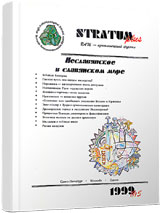Наименование Руси (герульская версия). Тезисы
The Naming of Russia (Heruls version). Theses
Author(s): Håkon StangSubject(s): History, Middle Ages, 6th to 12th Centuries
Published by: Издательский дом Stratum, Университет «Высшая антропологическая школа»
Summary/Abstract: The present research is dedicated to a new analysis of the issue concerning the process of the naming of Russia. The work consists of three sections, in the form of a scientific dissertation, published in the written form of a monograph in English (Hakon Stang. The Naming of Russia. /Meddelelser Universitet i Oslo Slavisk-baltisk avdeling 1996 ą77, Oslo 1996). The results of the research allow to restore in general features the following course of events:— The Naming of Russia was first registered in 839. In the same year in Byzantine the emperor Michael III Isavr came to the throne. Two facts come from the Greek chronicles in combination with Bertine annals and “Nachalna” Chronicle of the “Povesti vremennih let”.— At the appearance of unknown to them newcomers from the North, the people of Byzantine found out orally their self-naming, that was probably various. Among these names the most curious ones for Greeks were Rots, Roch, Rosh or a similar form, the sources of which should be searched in the complex context of Scando-Finnish-Slavic relations of the preceding centuries. This new for the people of Byzantine name led to the associations with the prophecy in the Old Testament about the “prince Ros” and Gog-Magog. Possibly “khan Rus” was introduced to them as a “red-beard” ruler of Ladoga (Raudbart?). All this could stir the interest to the earlier information about the known in the I-VI c. semi-mythical creatures, but that reflected the historic reality in the images of Northern outlying districts of the ancient ecumenical.— Courageous travelers of the year 839, having received in the course of their travelling the denotation “rhos”, got home to the Old Ladoga, where the new name, following the rules of transitions of the word “Ros” from Greek through Ancient Nordic (Scandinavian) penetrated into Vepsian, and also into Northern Russian that was exposed to the influence of Vepsian and Baltic languages, into the Slavonic language of the Slavs of Ladoga and Ilmeni Lake area, where from the name of Russia was spread all over Russia.
Journal: Stratum plus. Археология и культурная антропология
- Issue Year: 1999
- Issue No: 5
- Page Range: 119-147
- Page Count: 29
- Language: Russian

